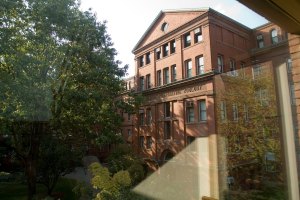Endowment return stable in 2001-02
The return on Harvard University’s endowment was relatively flat during the 2001-2002 fiscal year, with investment returns dipping 0.5 percent despite what Harvard Management Company President and Chief Executive Officer Jack Meyer termed a “harsh” investment climate.
The endowment’s overall value – which is affected by investment returns, new contributions, and payout for University programs – stood at $17.5 billion as of June 30, 2002, compared with $18.3 billion a year earlier. The University used about $750 million in endowment dollars to help finance the University’s $2.3 billion FY02 budget.
Endowment income provides critical long-term financial stability for Harvard’s academic programs. Historically, between 4 percent and 5 percent of the endowment is spent annually on Harvard programs. That money provides for specific activities donors have endowed over time, including financial aid, faculty salaries, and facilities maintenance. Among other things, endowment income supports Harvard’s generous student financial aid programs, which permit the University to admit qualified students regardless of their ability to pay.
Despite a negative return, the endowment beat or met investment benchmarks in 10 of 11 asset classes in the fiscal year ending June 30, 2002. The –0.5 percent return compares favorably with Harvard Management’s internal benchmark, the Policy Portfolio, which fell 4.5 percent. The drop also compares favorably to the 5.9 percent decline of the median institutional fund, as measured by the Trust Universe Comparison Service.
“This year was much like last year, with disappointing absolute returns but strong returns relative to benchmarks and other funds,” according to Meyer.
Meyer said the investment climate over the past two years was even tougher than he had anticipated. From June 30, 2000, to June 30, 2002, the Standard & Poor’s 500 Index fell 32 percent, the NASDAQ dropped 63 percent, and return on private equity indices were down roughly 40 percent. The Harvard endowment’s two-year decline of just 3.2 percent reflects the “benefits of diversification and significant value added by our portfolio mangers,” Meyer wrote in his annual “John Harvard” letter to University officials detailing endowment performance.
“We may not be out of the woods, but the endowment has weathered the two-year storm in fine shape,” Meyer wrote.
Five- and 10-year performance remained strong. Over the past five years, Harvard’s endowment has averaged an 11.6 percent return and outperformed the median institutional fund – as measured by the Trust Universe Comparison Service – by 6.2 percent. Over 10 years, the endowment’s annualized performance is 15.2 percent, compared with 9.9 percent by the median institutional fund. If Harvard’s endowment had grown at the rate earned by the median fund, Meyer said, it would be $8 billion less than it is now.
As in the broader market, funds invested in equities declined during the year, while investments in bonds and commodities buoyed the year’s results. Endowment investments in real estate, which fell 1 percent, were the only category that failed to meet benchmarks. Several asset classes rose in fiscal 2002, including commodities and domestic, foreign, and inflation-indexed bonds.
The endowment is not a single fund, but more than 9,400 individual funds, many of them restricted to specific uses – such as support of a research center or the creation of a professorship in a specific subject. The funds are invested by the Harvard Management Company (HMC), established in 1974 to oversee the University’s endowment, its pension and trust funds, and other investments.
Each school within the University uses a combination of income from investments, gifts from fundraising efforts, and tuition to cover the cost of educating students. Tuition from Harvard College, for instance, covers only about two-thirds of the total cost of a Harvard education. Harvard’s reliance on support from its endowment has increased in recent years. In 1992, endowment income provided 18.6 percent of Harvard’s total income. In FY02, that figure was about 32 percent.




